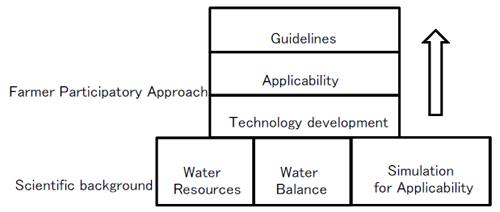Guidelines for water-saving vegetable production by Northeast Thailand farmers
Description
The “dry sand layer effect” enables the storage of a certain amount of excess rainfall from the rainy season which remains until almost the end of the dry season in northeast Thailand. Using the saved soil moisture for use during the dry season, a water-saving vegetable production method was developed through farmer participatory approach.
The guidelines (Fig. 1) were created as follows. From 2004-2005, a water-saving tomato cultivation method utilizing local resources was developed in Nong Saeng Village, Khon Kaen Province, Thailand. Within the period spanning 2006-2007, the method proved its adaptability and it improved yield level when used in conjunction with the local farmers' technique of returning plant residues to the soil. The technique was applied by 58 farmers out of 22 villages in two provinces (Khon Kaen and Mahasarakham). For the period 2009-2010, suitability of the method for several crops, such as leafy vegetables, fruit vegetables and beans, was evaluated through experimental application by 15 learning-center farmers in four provinces (Khon Kaen, Mahasarakham, Mukdahan, Sakhon Nakhon) (Fig. 2).
The guidelines were formulated in cooperation with the JIRCAS Rainfed Agriculture Project (RAP) and the Thai Agricultural Land Reform Office Project for Revitalization of Degraded Environment in Land Reform Areas through Integrated Agricultural Development (Pro-IAD). The protocol for establishing the guidelines was as follows: At first, RAP and Pro-IAD discussed and decided the making of two types of guidelines. One is the no-watering cultivation for paddy fields after harvesting; the other is a water-saving cultivation technique for general conditions. Both of them are for leafy vegetables, fruit vegetables and legumes. Then volunteer farmers were selected from four provinces of the Pro-IAD area. Farmers chose the test crops on their own. After the experiment, all the farmers assembled, discussed their results and formulated the guidelines.
The first water-saving cultivation guideline for general crops reduced watering from twice a day to once every five days. This will be useful for both organic and chemical agriculture. Watering is essential to dissolve fertilizers into the soil. On the other hand, the no-watering cultivation technique is recommended for groundnut, water melon, melon and eggplant. The water-saving cultivation method does not require special materials or other equipment.
The two guidelines have been disseminated through farmer-to-farmer extension method since December 2010, and since not everything could be covered by the guidelines, techniques based on their own experiences and farming environments were shared by experienced farmers to neophyte farmers through training.
Figure, table
-
Fig.1 Contents of Guidelines for-Water-saving Vegetable Production -
Fig.2 Protocol of Establishing the Guidelines for-Water-saving Vegetable Production
- Affiliation
-
Japan International Research Center for Agricultural Sciences Crop Production and Environment Division
- Classification
-
Research B
- Term of research
-
FY2006~2010
- Responsible researcher
-
ODA Masato ( Crop Production and Environment Division )
CHONGPRADITNUN Praphasri ( Department of Agriculture Thailand )
- ほか
- Publication, etc.
-
Oda et al. (2006) JIRCAS Working Report No.47:115-120.
Oda and Moroizumi (2007) Journal of the Japanese Agricultural Systems Society. 23(3):245-250.
Oda and Ogura (2008) Journal of the Japanese Agricultural Systems Society. 24(1):57-64.
Oda (2009) Research for tropical agriculture. 2(1):1-7.
Oda (2011) Rainfed Agriculture in Indochina. Yokendo. p.46-53.
- Japanese PDF


